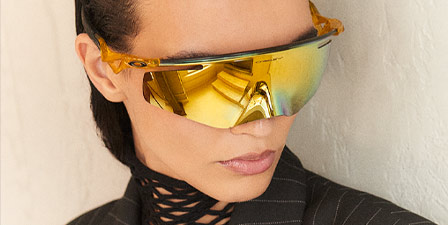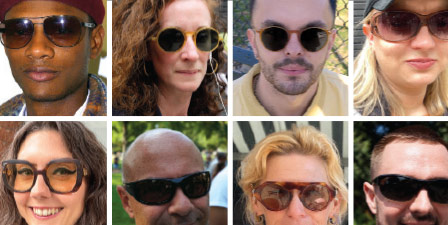Everyone knows the story of Goldilocks. Odds are if you’re reading this, you heard it as a child growing up, and odds are just as good you might have told it to one of your own children. The pint-sized burglar practices her future criminal career by busting into the three bears’ house and availing herself of their food and amenities, seeking porridge and beds that are “just right.” Imagine how differently the story would have been though, if Goldilocks had broken in to find only one bowl of porridge… that… was too small. And one bed… that was too hard. Does it still have the makings of a classic bedtime story if it’s simply about a girl who discovers that she has simply got to put up with what she is handed, regardless of its suitability to her needs?
Whether we realize it or not, that’s the situation facing most eyeglass wearers in search of a new pair of frames. Once upon a time, eyeglasses had a certain degree of customizability to them. Speak to an old-time optician, and he or she will tell you of the time when selecting a frame wasn’t just about shape and color but size as well—opticians would choose different eye, bridge and temple sizes to make sure a frame fit a patient as comfortably as possible while also looking good. As frame design began to branch out in terms of fashion and branding, something curious happened. Patients were suddenly given a myriad of new shapes, styles and colors to choose from, but with a wider availability of designs came a narrow availability of sizes. If a patient tries on a new pair of frames now, and they’re too big or small, the answer to “does it come in another size?” is almost assuredly “no.” For most people, this isn’t too much of an issue. Frame doesn’t fit? Move on. What happens when you’re not most people, though? What happens to the man with the giant head, the woman with the tiny face? What about Asian and African-American patients who want to look stylish but whose bridges are too flat to comfortably wear zyl frames without separate nosepads?
For most of the 1990s and early 2000s, the answer to THAT question was, “they’re SOL” (and you can imagine that means “so out of luck”). Frame’s too tight for your giant noggin? Tough—it’s gonna squeeze you all day long. The eyewire dwarfs your tiny face and makes you look like you’re wearing goggles? Tell your friends that steampunk is in this year.
Thankfully, in recent years, the optical world has—like the world at large—begun to pay attention to the personal needs and issues facing a wider variety of individuals, and (doubly thankfully) moved to address them. Take the large headed gentleman, for example (a category to which I myself belong, as my 55-eye-size frames will attest). For years, as an optician, I struggled to outfit my big-headed male patients with glasses that were both comfortable and looked good. For a while, my answer was often resorting to turning sunglasses into ophthalmics, a solution that may have provided my patients comfort but didn’t exactly send them out the door looking their best. I came to a point where I believed that there must be something in the water down here in Texas proving the adage that everything is bigger in the Lone Star State—it seemed I was struggling to outfit a giant-headed-dude two or three times every week. As it turns out though, we of the melon head aren’t as rare as I once thought, and in response, multiple frame manufacturers have come forward with lines geared toward guys who want their frames to be comfy AND stylish. On the flip side of the coin, more women’s lines (which curiously seem to have been addressing large-headed women far longer and more reliably) are beginning to offer petite fit frames for female patients in need of a smaller eye size.
Seemingly in response to just this debacle, many children’s lines have also begun to downplay their more blatantly-kiddie elements like bright colors and cartoon characters, offering miniature versions of adult frames that suit tiny-faced grown-ups as well as they do the more serious tot on the playground. (I myself used to reliably put one of my adult female patients in Ray-Ban juniors every year, much to her pleasure and comfort.)
The biggest push though, has been in the avenue where it’s perhaps most needed. For years, African-American and Asian patients who wanted to keep up with current fashion trends were put into the precarious position of keeping their fingers crossed for the decades when metal or rimless frames circled back into style. Flattened nose bridges long made zyl frames both uncomfortable and a poor choice from a standpoint of optical quality, as there was nothing to keep them from slipping/setting poorly and negatively affecting patient vision.
For a long time, in a sad reflection of society at large, those patients were essentially told “deal with it.” Greater social awareness in recent years has thankfully trickled into the optical world, giving birth to the Universal Fit frame. With a built-up bridge that serves the same function a prominent nose would, Universal Fit frames fit… well, universally, offering African-American and Asian patients their first opportunity to wear comfortable and stylish frames.
So, what’s the implication of all this? A lot of meetings with your frame reps, that’s what. For the first time in a long time, you have the ability to offer your patients frames designed specifically to fit their needs and give them a totally satisfying optical experience—not merely an “acceptable” one. Got a lot of big heads, small faces? Serve a largely African-American clientele? Crunch some numbers and get cracking on how much of that frameboard to fill up with what styles. Your patients will be happy. Your bank account will be happy. And somewhere out there Goldilocks will be smiling, having purloined a pair of frames that are just right. ■
February 2018
Frames












